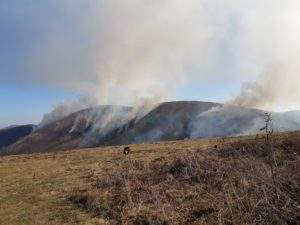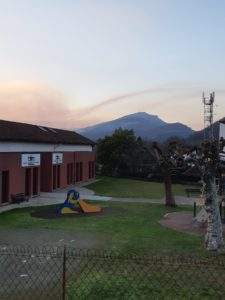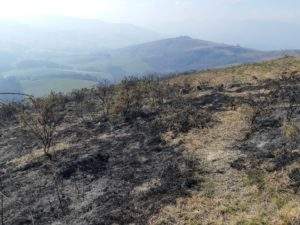Basque Country Honeymoon!
February School Vacations for Zone B in France meant it was finally time to take our official Honeymoon!
Two weeks in the Basque country!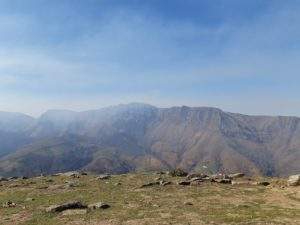
Why the Basque Country?
To be honest le Pays Basque wasn’t our first choice. We wanted to go to Morocco first. Then, thinking that the high altitudes there in February would be too cold, we set our eyes on Portugal. But a Eustachian tube (the small tube going from the inner ear to the throat) problem aggravated by our August trip to the States eliminated air travel as an option. Under doctor’s orders, we avoided traveling other than by car. (Trains create pressure differences when they go through tunnels.)
So, somewhere closer to home yet far enough away to represent a break from our daily routines and leave us with some new cultural knowledge.
Voila, the Basque Country!
We were lucky. The week we chose was one of unseasonal warmth (20 degrees!) and dryness near Saint-Jean-Pied-de-Port.
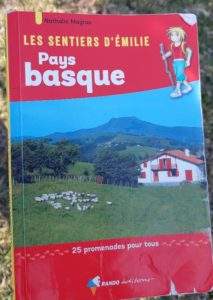
We set out on daily hikes, easy ones from a guidebook called “Les Sentiers d’Emilie” that we found in our Airbnb. I was generally in charge of choosing the destination. I aimed for those of around 3-4 hours and enough of an elevation gain that we would feel challenged.
In comparison with our pre-lune to Strasbourg, the Basque country was wonderful! Not that we didn’t enjoy ourselves in Strasbourg. But it made a difference not having to navigate through throngs of tourists. And being able to prepare our own meals and having easy access to the beauty of nature certainly made a stark contrast with the earlier trip.
So, what were the standouts of the trip?
Roads
If you want to visit the Basque Country, access to a car is a must. And a small car is preferable because the roads are sinuous as hell. These are not roads for the queazy. But they are in good repair – like all roads I’ve seen in France.
Agriculture
![]() Agriculture in le Pays Basque is based more on animal husbandry than in the Pays-de-la-Loire though there are
Agriculture in le Pays Basque is based more on animal husbandry than in the Pays-de-la-Loire though there are![]()
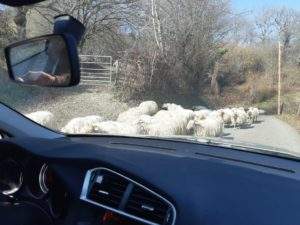
plenty of plant crops too. Climb almost any hill, and you’ll pass by flocks of sheep happily clanging their bells in troupeaux of 50 or more. Sometimes you’ll meet bergers and their sheepdogs escorting the animals from one field to another.![]()
The hills to my Upstate New Yorker eyes, seem curiously denuded, almost Dr. Zeussian. There are very few trees, meaning that you can really see the contours.
Because of the unseasonal warmth and dryness, sheep farmers took the rare opportunity to clear their fields of thistles and brush. Where one thistle takes hold, there will soon be many more. And since the spiky plants aren’t eaten by sheep, little by little, the mauvaise herbs transform entire fields into less productive areas for sheep raising.
How do the farmers get rid of the brush and thistles?
They set controlled fires on the hillsides. When there’s no wind, the fires climb vertically. It’s relatively safe, though if you want to be extra careful, there is a webpage you can check if you’re planning a hike in the hills.
During our Honeymoon, the air quality was poor because of all the fires on the hillsides (for breathing and sightseeing.) The days that started clear and gave us envie to climb a hill to see the snow-capped mountains to the South were obstructed by afternoon smoke. Sometimes at night we would see orange flames on the black hills from fires that hadn’t gone out yet.
Basque Culture
On one of the days of our trip, there was a small Basque Festival. It was nothing extravagant but still worth stopping to watch. A few dozen people paraded from one side of Saint-Jean-Pied-de-Port to the other. Once at the far end, under a kind roofed market space, they performed dances, sang, and put on a theatrical production.
All in Basque of course!
What stood out most from this cultural display was that aside from a few musicians, all the performers were children and teenagers.
There are whole books written about Basque Culture, and as an outsider, I can’t hope to add to the canon on the subject. But I will say, as for surviving sub-cultures in France, Basque is one of the strongest. It is infinitely stronger than the remaining Breton, Alsatian, Bernaise, and Corsican sub-cultures. If I’ve left out other important sub-cultures/languages of France it’s because I haven’t encountered them yet.
Basque sub-culture is so strong as a result of the unification of the Basque language in the 1970s and the because inhabitants of the region market its particularities and lifestyle to tourists. Of note, the foods of Basque country are world-renowned, and there is an outsized share of Michelin-star restaurants there compared to the Basque population.
Alternative Currency
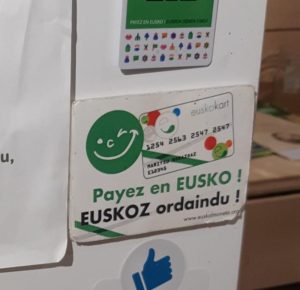 One day at a store selling regional foodstuffs, I noticed a sign asking customers to pay with the Eusko. I asked the shopkeeper about it, and she explained that it is one of the most-used local currencies in Europe. I don’t know about the factuality of that but according to the Eusko website, more than 40,000 individuals and 1,300 businesses use the currency. The Eusko is supposed to strengthen the local economy, fight against big-box stores, and encourage customers to return. You can even get a portion of your salary in Euskos.
One day at a store selling regional foodstuffs, I noticed a sign asking customers to pay with the Eusko. I asked the shopkeeper about it, and she explained that it is one of the most-used local currencies in Europe. I don’t know about the factuality of that but according to the Eusko website, more than 40,000 individuals and 1,300 businesses use the currency. The Eusko is supposed to strengthen the local economy, fight against big-box stores, and encourage customers to return. You can even get a portion of your salary in Euskos.
Alternative currencies aren’t new to me as an idea. Ithaca, where I’m from, has had Ithaca Hours for years. It permits you to exchange an hour of labor for another person’s hour of labor. Still, even if the idea isn’t novel, I love the idea of the Eusko.
Proximity to Spain
One of the benefits of going to the Pays Basque is that it is a stone’s throw away from Spain. In fact, 90% of the Basque population lives on the Spanish side of the border. Foodstuffs and Petrol are cheaper on the Spanish side and because of the European Union’s wisdom, there’s no hassle passing from one side to the other.
We took advantage of our closeness to Spain the explore the Grottes of Zagarramurdi, famous for being the center of Europe’s biggest witch hunt, and the port city of San Sebastian.
February is off-season for tourism au Pays Basque. My wife and I were happy to have gone there in winter. The sinuous roads are already hazardous enough without scattering thousands of more cars onto them. Apparently, in summertime, the whole area is awash in tourists.
Taken together, it was a wonderful trip! I’m pleased with what I learned and took away from the Pays Basque and I recommend the region to those who haven’t traveled there yet.
Have you ever been to the Pays Basque? Did you have a good time? What do you think about Ecobuage in this time of climate change?
